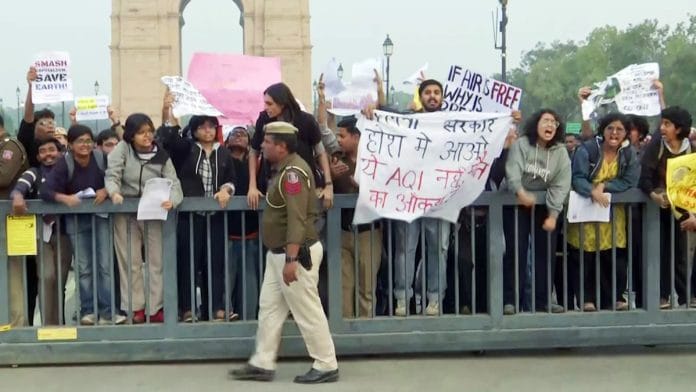New Delhi: The Bhagat Singh Chhatra Ekta Manch (BSCEM), a lesser known outfit which identifies as a students’ rights group, now finds itself at the centre of the Delhi Police probe into ‘Naxal links’ to the chaos that erupted during a protest against rising air pollution levels here Sunday. The protesters allegedly attacked police personnel with chilli spray and raised slogans in support of slain Maoist commander Madvi Hidma.
Police sources said investigators, after the arrests of 22 people, narrowed down on two groups: BSCEM, and Himkhand, which identifies as an environmental advocacy group. “Several BSCEM members were seen raising pro-Hidma slogans. Investigators are probing their networks and other groups they are affiliated with,” said a senior police officer.
On 19 November, BSCEM on its Instagram—with more than 3,000 followers—put up a post calling for a protest for clean air. The same day, another post was put up with a “red salute” for Hidma and terming the encounter in which the Maoist commander was killed “fake”.
The post accuses “Brahminical Hindutva Fascists Forces backed by BJP” of intensifying attacks on tribals.
BSCEM has in the past also put up posts in solidarity with G.N. Saibaba. A former Delhi University professor, Saibaba was charged under the stringent UAPA in the Bhima Koregaon case. He was acquitted in March 2024, and died in October that year. BSCEM also regularly posts on students’ issues, offering solidarity to protesting student groups across India.
On 14 November, a BSCEM representative was part of the press conference organised at the Press Club of India here on the movement to demand clean air. Senior advocate Prashant Bhushan was also part of this press conference.
Ravjot, a member of BSCEM, wrote an opinion piece for The Indian Express earlier this month, titled, ‘While protesting against air pollution at India Gate, it became clear to me: For the state, citizens are not the priority’.
Earlier, the organisation had also put up Instagram posts giving “salutations” to the youth of Nepal following protests there. BSCEM called the ‘Gen Z’ protests in Nepal a message for various “revisionist communist” parties.
Back home in India, it had also come out in support of the farmers’ protest.
BSCEM’s Instagram account also has a post “condemning” the killing of Hidma and others by security forces. The post is in collaboration with Nazarriya Magazine which identifies as “an anti-imperialist, anti-feudal Marxist magazine that focuses on the political issues of the working class, peasantry, students, intellectuals and professionals”. It says it is “staunchly in resistance against fascism, post-modernism and revisionism”.
The caption of the post on Hidma’s encounter also mentions Forum Against Corporatization And Militarization (FACAM). FACAM, per its website, was established in 2022 and identifies as a “joint platform of various organisations and individuals ranging from students, lawyers, women’s rights groups, minority rights groups, academics, teachers, intellectuals, trade unions, labour rights groups, journalists and writers, based in Delhi, India”.
BSCEM, along with other groups, are believed to be affiliates of FACM.
The protest at India Gate wasn’t Bhagat Singh Chhatra Ekta Manch’s first run-in with the law. Its members were booked earlier this year for defacing a wall at the Jawaharlal Nehru University. The students, who had gone to meet friends in JNU, allegedly defaced the wall near the School of Social Sciences with slogans on Bastar and communist icons.
Earlier in 2021, members of the organisation were also detained following a protest and clash between residents of Haryana’s Khori village and police personnel over demolitions of the homes of local villagers. Bhagat Singh Chhatra Ekta Manch was also part of the consortium of student organisations that called for the screening of the BBC documentary on the 2002 Gujarat riots at Delhi University’s Faculty of Arts in 2023.
(Edited by Amrtansh Arora)
Also Read: Who was enemy no 1 at Delhi’s pollution protest? Capitalism







Obviously it’s the Maoist or as CM of Maharashtra terms them “urban naxal”. Time and time again I have questioned why do these protests happened only when BJP came to power and not during AAP’s tenure.
Naxalism is a dying ideology but these urban ones are not going to go down that easily